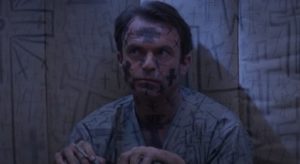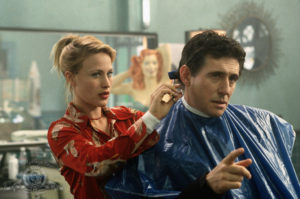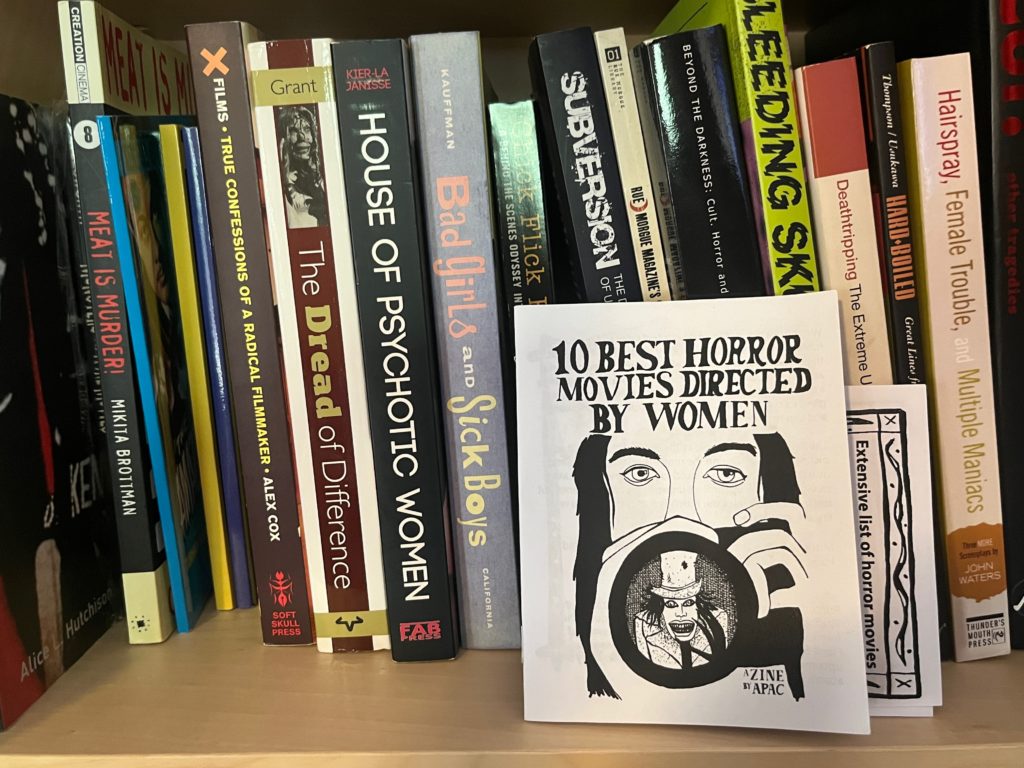What do you know? Another APac mini ‘zine is shaping another OTC entry. I’ve over-relied on these little ‘zines because my will to write came back so late in the game that I had very little time to create any sort of theme for Oddtober. I didn’t even have enough time to just read some new horror and supplement it with books I’ve read but have yet to discuss. These ‘zines help me frame a topic and give me the urge to consume media new to me, and since they focus on films, I can, conceivably, create a new entry after three hours or less. I’m grateful I found them before Oddtober began.
 I had high hopes for Sickest Catholic Horror Movies and it didn’t disappoint, not really, but I can say that Amèlie Paquet’s taste in religious horror movies is eccentric. The ‘zine lists some very good films, like Martyrs, The Devils and The Exorcist, which gave me the impression that the other films listed would have similarly strong and obvious ties to Catholic horror. But “sickest” covers a lot of ground, and in some cases it may not mean gory. It may not mean “sick” as a synonym for “cool.” It may mean “so bad it’s good except it went on too long and became bad again.”
I had high hopes for Sickest Catholic Horror Movies and it didn’t disappoint, not really, but I can say that Amèlie Paquet’s taste in religious horror movies is eccentric. The ‘zine lists some very good films, like Martyrs, The Devils and The Exorcist, which gave me the impression that the other films listed would have similarly strong and obvious ties to Catholic horror. But “sickest” covers a lot of ground, and in some cases it may not mean gory. It may not mean “sick” as a synonym for “cool.” It may mean “so bad it’s good except it went on too long and became bad again.”
Two other films APac features in this “sickest” list are so… not good that I almost don’t know where to start. With the hope of assembling a quick entry I watched one of the films on APac’s “sickest” list thinking I could discuss it while linking it back to some insane childhood story or amusing call back to my various neuroses and bing, bang, boom! Another Oddtober entry finished.
Except I watched John Carpenter’s In the Mouth of Madness and I don’t even know what to do. So I stayed up late and watched another film on the list, Stigmata, and now I’m even more fucked.
I disliked In the Mouth of Madness so much that I genuinely have no idea what to say. Do I address the various problems in the film, like an incoherent plot filled with so many bizarre images that the horrible characterization is almost negligible in comparison? Do I just shake it off and ignore it and discuss Stigmata instead because at least I can easily verbalize what was wrong in that film?
 I guess the best thing to do is rip the band aid off and do my best. In the Mouth of Madness stars Sam Neill as an insurance fraud investigator, John Trent, who is recruited to find Sutter Cane, a Stephen King-style writer, who has disappeared as his work causes those who read it to lose their minds and become violent but even those who haven’t read it go nuts as well, as there are riots at stores that sell out of the book before people can buy it. It makes sense if you don’t think about it. Anyway, Trent is hired to find Cane, because when you need to hunt down a famous author who has disappeared under paranormal circumstances, you need a free-lance insurance fraud investigator. Trent and some woman whose presence in the movie is so meh that I cannot recall her name, drive to Cane’s hometown and encounter bizarre, unrelated, non-thematic issues, like running over old men on bikes, feral children chasing dogs, and a strange land lady with a man handcuffed to her leg. They find Cane and we have no idea why his books are driving people crazy or what his motivations are in causing such chaos. It ends with Trent in a loony bin and we have no clue what all these tangents mean, and the only reason it seems vaguely Catholic is because John Trent covers himself and the walls in his padded room with crosses he wrote in black crayon.
I guess the best thing to do is rip the band aid off and do my best. In the Mouth of Madness stars Sam Neill as an insurance fraud investigator, John Trent, who is recruited to find Sutter Cane, a Stephen King-style writer, who has disappeared as his work causes those who read it to lose their minds and become violent but even those who haven’t read it go nuts as well, as there are riots at stores that sell out of the book before people can buy it. It makes sense if you don’t think about it. Anyway, Trent is hired to find Cane, because when you need to hunt down a famous author who has disappeared under paranormal circumstances, you need a free-lance insurance fraud investigator. Trent and some woman whose presence in the movie is so meh that I cannot recall her name, drive to Cane’s hometown and encounter bizarre, unrelated, non-thematic issues, like running over old men on bikes, feral children chasing dogs, and a strange land lady with a man handcuffed to her leg. They find Cane and we have no idea why his books are driving people crazy or what his motivations are in causing such chaos. It ends with Trent in a loony bin and we have no clue what all these tangents mean, and the only reason it seems vaguely Catholic is because John Trent covers himself and the walls in his padded room with crosses he wrote in black crayon.

Even were I to take In the Mouth of Madness as a film that is meant to just be… sort of scary with a dash of ridiculousness, I’d have to overlook the appalling acting from everyone involved, including Sam Neill, whose character is such a dick I wanted him dead within the first twenty minutes. He does not play assholes well. Or maybe he didn’t play John Trent’s brand of assholism well. But he’s a great actor and it was weird seeing him in this cringy role. Regardless of the quality of the actors in this mess, nothing made sense, we have no idea why any of this happened, and the best scene was when John Trent punched an asylum orderly in the balls.
Stigmata is a baffling mess, but at least I understand its links to Catholicism. But mostly this film made me cringe, which is all the more awful because I like both leads, Patricia Arquette and Gabriel Byrne. Byrne plays Father Andrew, a priest who is a scientist and tasked with researching religious miracles. He is sent to look into Frankie, a Pittsburgh hairdresser, who is an atheist but is also displaying the signs of stigmata. Frankie came into possession of a rosary owned by a dead priest who found and translated the Book of Thomas, a gospel that is said to be as close to coming from the mouth of Jesus as any known Christian document. In turn, the priest who owned the rosary possesses Frankie and Father Andrew must try to ferret out what is happening to her. In the end, he thwarts a church attempt to kill Frankie, a plot predicated on the notion that the Christian faith would be destroyed if the Gospel of Thomas is released and people find out the Gnostics were right.
 The movie reeks of Spice Girls circa 1997. Frankie wears bright colored plastic jelly shoes with socks. As a hairdresser, she and her friends have some of the worst hair styles imaginable. She lives in a loft that looks way more expensive than a hairdresser could manage and is filled with mannequins and hundreds of candles so we know Frankie is whimsy personified, a hip free spirit. Father Andrew is just… good looking and evidently very easily sexually manipulated despite his clerical vows. He clearly develops a thing for Frankie and is ultimately the hero of this piece but mostly he just shoots intense gazes and struggles mightily with his romantic feelings for Frankie, feelings that trump his desire to get the real word of God disseminated to the people.
The movie reeks of Spice Girls circa 1997. Frankie wears bright colored plastic jelly shoes with socks. As a hairdresser, she and her friends have some of the worst hair styles imaginable. She lives in a loft that looks way more expensive than a hairdresser could manage and is filled with mannequins and hundreds of candles so we know Frankie is whimsy personified, a hip free spirit. Father Andrew is just… good looking and evidently very easily sexually manipulated despite his clerical vows. He clearly develops a thing for Frankie and is ultimately the hero of this piece but mostly he just shoots intense gazes and struggles mightily with his romantic feelings for Frankie, feelings that trump his desire to get the real word of God disseminated to the people.
If I overlook the 1990s cringe aesthetics and pretend that there was anything approaching chemistry between Arquette and Byrne, I still hit a brick wall considering the plot. There are so many theological and common sense issues that they require yet another OTC point by point breakdown.
–When did the Catholic church begin to recognize possession by ghost? Because Frankie isn’t being possessed by a demon, she’s being possessed by a dead man’s soul.
–How on earth does the possession by a ghost trigger stigmata? What possible purpose is there for a dead priest to infest his own rosary and then enter the body of some random girl with spacebuns and a hipper than thou apartment and slowly give her the five wounds of Christ?
–Since when did the Catholic Church believe that demonic possession is like the common cold and can be transmitted like cooties in a kindergarten? According to what I recall, possession can only occur when someone opens their psyche to possession through substance abuse, sexual perversity, greed, or actual invitation to the demonic. You can’t get possessed by handling a rosary a priest once owned.
–The above applies to ghosts, too, since there is no Catholic belief that ghosts can possess anyone, let alone via transitive property.
–The Catholic Church has been aware of the Book of Thomas since 1945. They’ve been struggling with tamping down Gnosticism for centuries. Why on earth would a Pittsburgh hairdresser’s stigmata suddenly plunge the world into chaos because a Book of Thomas believer decided to invade her body and how on earth would that be the final straw on the camel’s back in terms of legitimizing that particular gospel? Out of all the other attempts to bring down the Catholic church, this hairdresser’s fits will be the final boss?
–What is the purpose of a ghost possessing an atheist and giving her stigmata? Initially I wondered if it was a nod to the gnostic idea that the kingdom of God is within us all, but wouldn’t that message have been better delivered by a genuine Christian who understands the significance of what is happening to them?
–Why is possession by a ghost who somehow induces stigmata visually indistinguishable from being tortured by demon possession?
–The final scene where Frankie essentially becomes a new incarnation of St. Francis of Assisi was a garbled, fairy princess mess and I resent such a strange, pointless connection between these two. St. Francis received his stigmata after a vision of an angel during a fast, after he spent years ministering to lepers, after he made very good on his vows of obedience and poverty. His stigmata was a reward for his stalwart faith and he received all five wounds at once. Francis suffered from the wounds but ultimately the stigmata was a gift, a sign that his faith was rewarded via proof of Divine intervention. Frankie, on the other hand, suffers and for no purpose she recognizes. She is not being rewarded. She is being punished, and she is being punished worse than a drunken pedophile being tortured via demonic possession. What possible good does it do to give an atheist stigmata when she was never looking for proof, when she had no desire to find God within her, if she has no idea why this is happening to her?
Patricia Arquette has a very fey, vulnerable quality about her that works because there is generally something steely behind the sweetness but in this movie she seems like Baby Spice simpering and flirting with the priest. No bite behind it like her role as Alabama in True Romance. She’s irritating, and one needs their stigmata infested heroine not to be irritating. Gabriel Byrne’s Father Andrew doesn’t really evince the power of his beliefs – he’s just a handsome priest who makes bizarre decisions because he’s taken with pretty Frankie.

The whole film is full of bizarre decisions. Like Frankie thinking people will let her work on their hair when her wrists are covered by bloody bandages that she does nothing to hide. Or how about Frankie’s friends, who think that when your friend has holes running right through her wrists that the best possible thing to do is get her loaded at a club so she can unwind (she promptly develops the crown of thorns scars on the dance floor and then runs out into rainy traffic).
I curse my decision to watch films from Sickest Catholic Horror Movies that I had not yet seen. I should have rewatched Martyrs, which for all its flaws (I hate the ending so much) is a provocative, interesting film. Fuck, Ken Russell’s The Devils would have been a helluva movie to revisit. Even going over the well-trod ground of The Exorcist would have been more interesting than reacting with a jaded sigh to these two films.
APac’s ‘zines, even when I question her choices, are always thought provoking. And I guess there’s nothing wrong, really, discussing why I dislike some of the films she mentions in her ‘zines, especially this go around because I think “sickest” can mean that these films handle Catholicism poorly, and if that is the case, these two films definitely belonged on that list. Instead, if I were a betting woman, I would wonder if she was trying to steer away from all the usual suspects, like The Omen, The Prophecy, The Rite, Constantine, The Exorcism of Emily Rose and others. I appreciate that she tries to present films that are not ringers.
And sometimes it’s kind of fun to discuss bad films, if I can corral my tendency toward hyperbolic savagery. But at any rate, this ‘zine encouraged me to watch two films and they both sucked and here we are. If you want to see the rest of the films mentioned in this micro ‘zine, you can get your own copy of this ‘zine here.
Have you seen In the Mouth of Madness or Stigmata? Do you agree with my assessments or have I got this completely wrong. Feel free to sound off in the comments.
